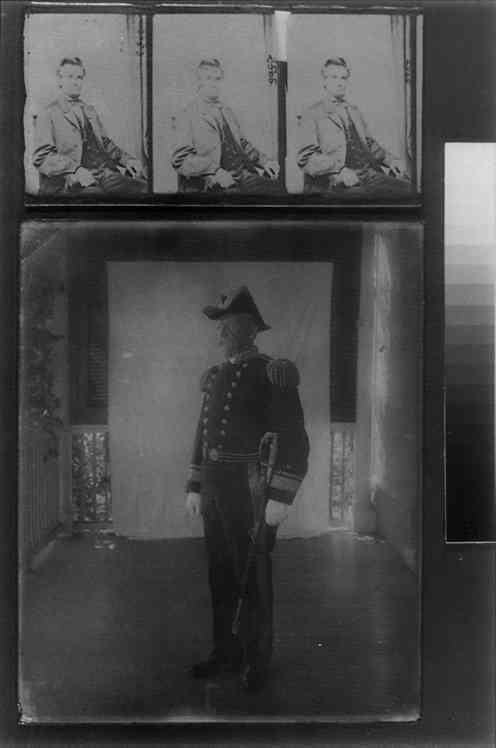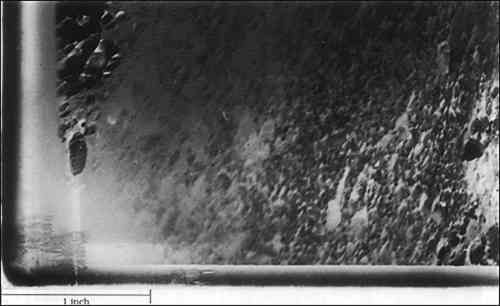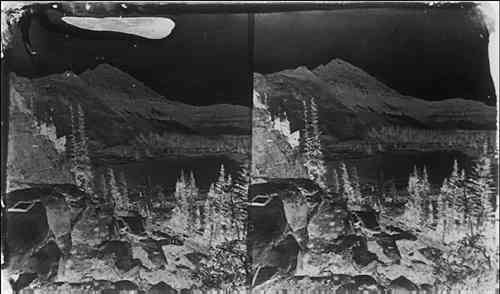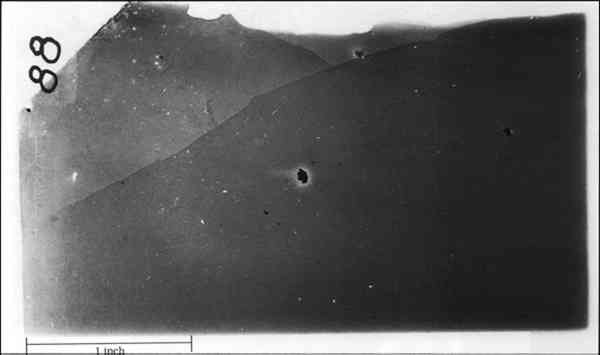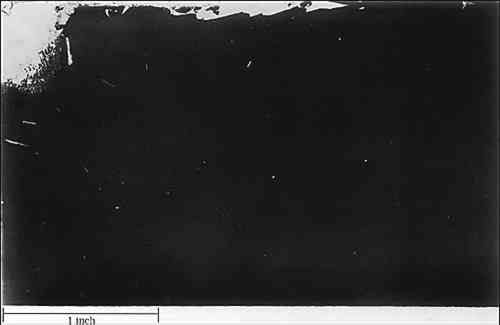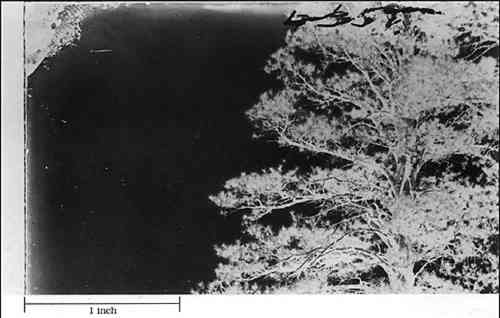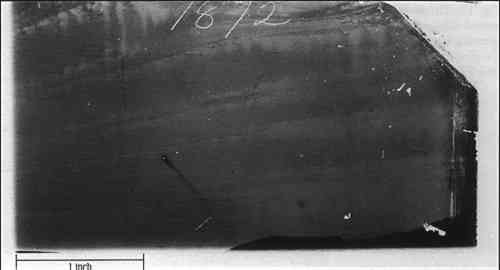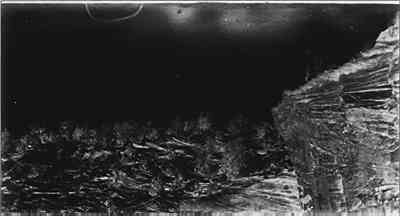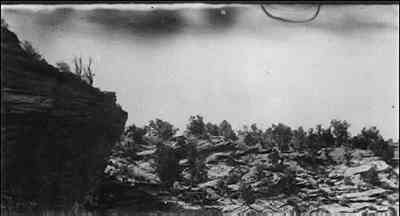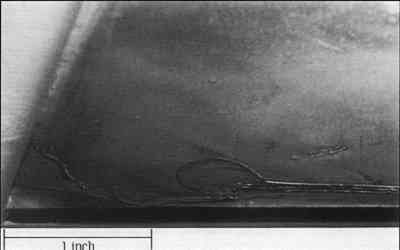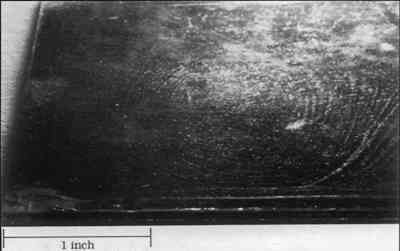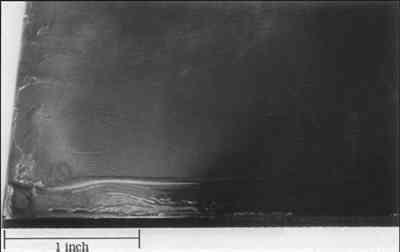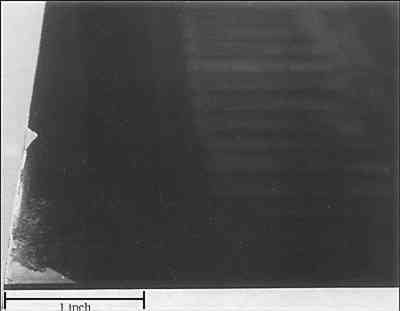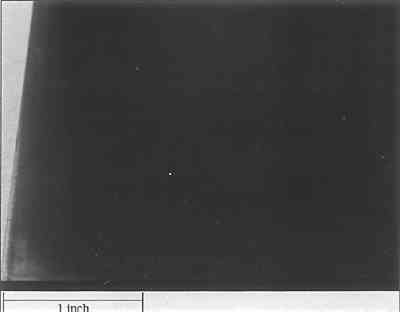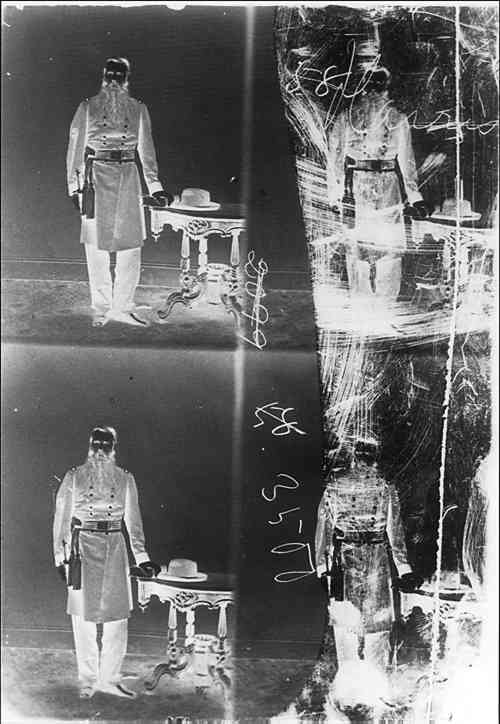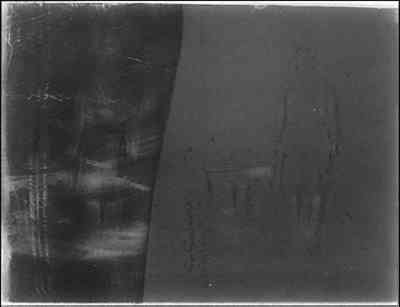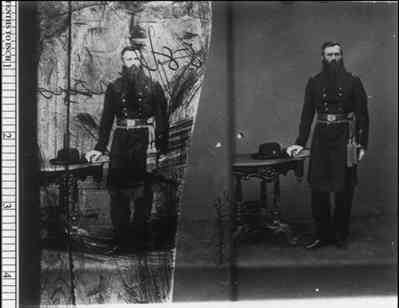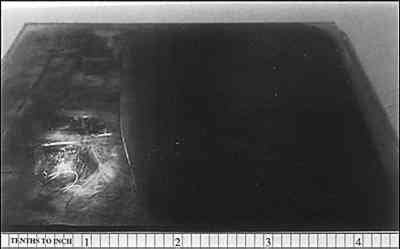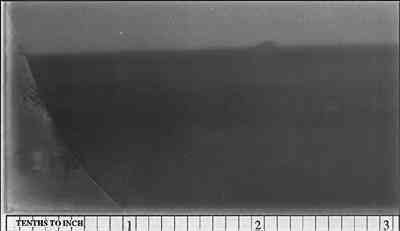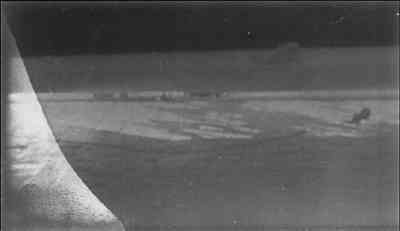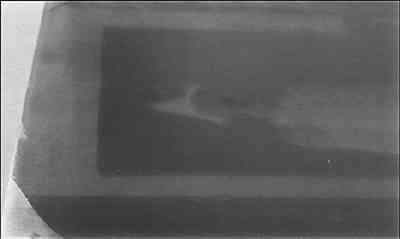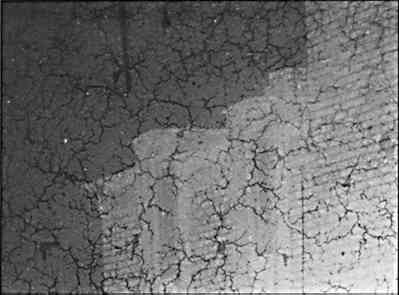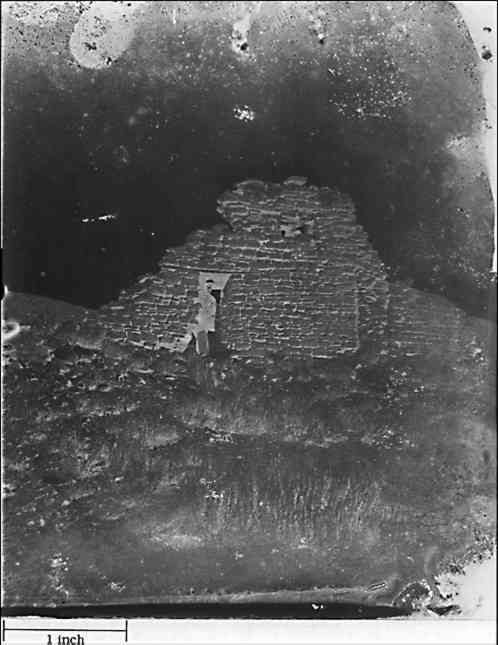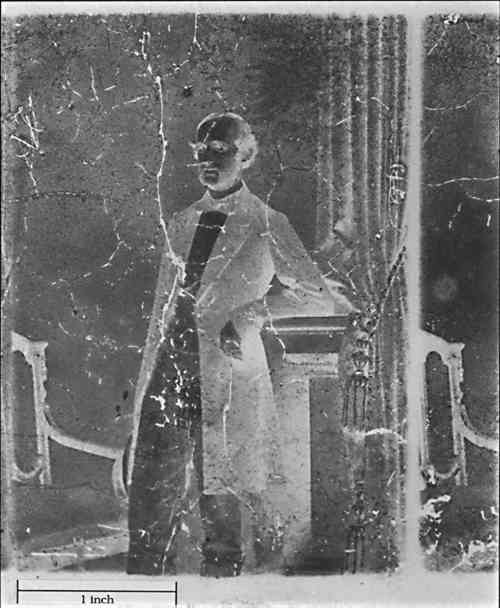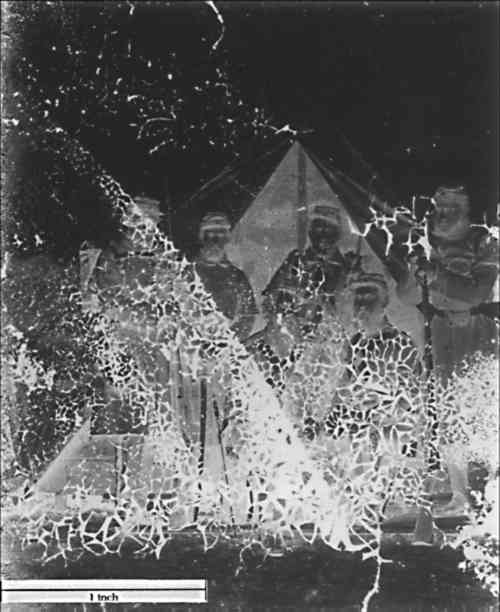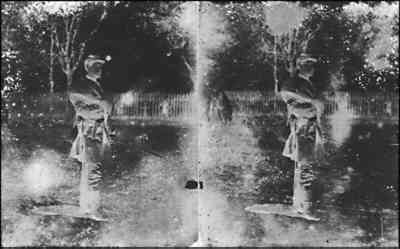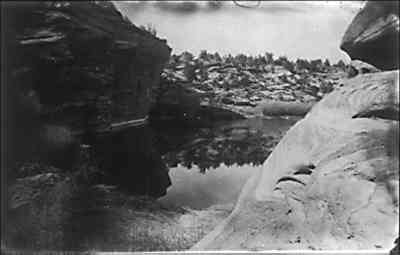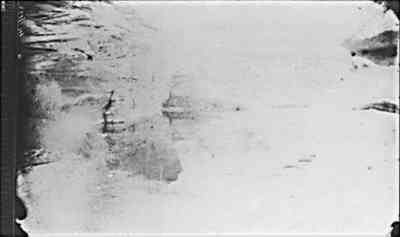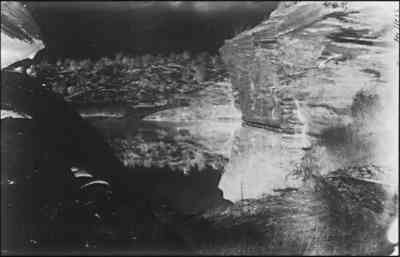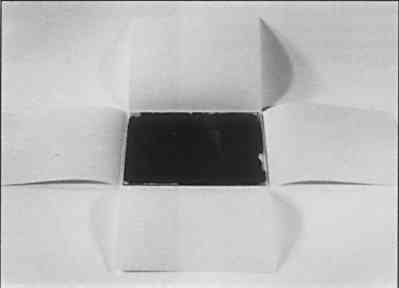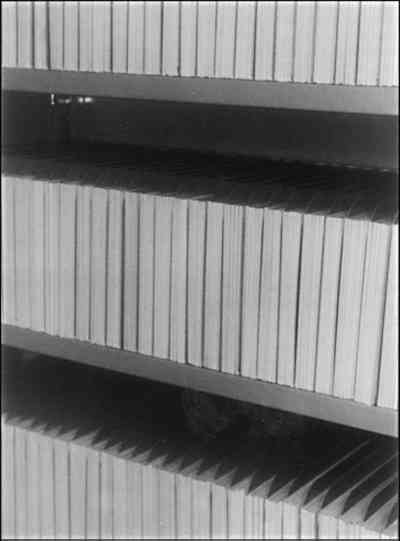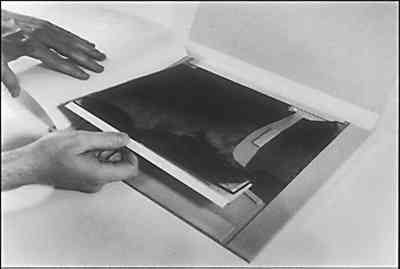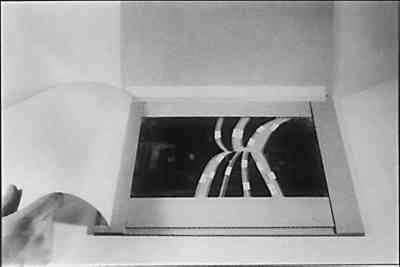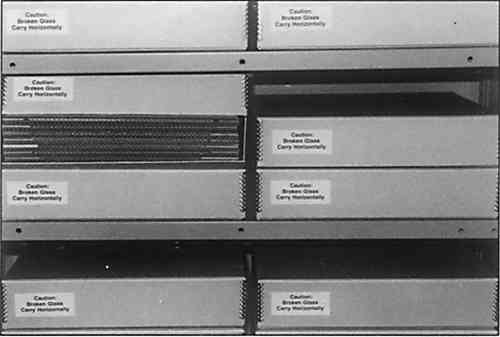PRESERVATION OF 19TH-CENTURY NEGATIVES IN THE NATIONAL ARCHIVESCONSTANCE McCABE
ABSTRACT—This article discusses an extensive project to preserve nearly 8,000 collodion glass plate negatives of portrait and field work by noted photographers Matthew Brady, William Henry Jackson, Timothy H. O'Sullivan, and others. Information is presented about the constituents of collodion negatives and the characteristic deterioration related to inherent compositional factors. Finally, preservation issues such as photographic duplication, rehousing, and storage are addressed. 1 INTRODUCTIONSEVERAL SERIES of important 19th-century glass plate negatives in the holdings of the Still Pictures Branch of the National Archives were selected for a major preservation project. Negatives included in this project are from the following record groups: the Records of the Office of the Chief of Engineers (RG 77). Records of the Geological Survey (RG 57). Records of the Smithsonian Institution (RG 106), and Records of the office of the Chief Signal Officer (RG 111), Nearly 8,000 negatives are involved in the project, ranging in size from 2 � � 3 ⅛ in to 18 � 22 in. The Western Survey photographs, dating from 1867 to 1883, are among the first photographs of the North American West. Many of the survey photographers are considered to be the most accomplished of that time. Photographer William Henry Jackson worked under the direction of Ferdinand V. Hayden documenting survey activities in Nebraska, Wyoming, Colorado, Utah, Idaho, and Montana (1869–78).Timothy H. O'Sullivan and William Bell, under the direction of George M. Wheeler, photographed explorations and surveys west of the 100th meridian (1871–74). O'Sullivan also photographed for the Clarence King Survey of the 40th Parallel (1868–70 and 1872). The negatives also include the work of John K. Hillers, E. O. Beaman, and James Fennemore, all three of whom photographed under the direction of Jhon Wesley Powell for the survey of the Rocky Mountain region (1871–78), and William R. Pywell, who photographed the Yellowstone expedition of 1873 under the direction of Col. David S. Stanley. The Western Survey photographs helped convince the federal government to preserve some wilderness areas as national parks. The photographs of the Matthew Brady1 Studio include views taken on the battlefields of the American Civil War (1861–65), as well as portraits of notable Americans such as Abraham Lincoln, Walt Whitman, Frederick Douglass, and Gen George A. Custer. Many of the images were made by Brady's employees, including Alexander Gardner and Timothy H. O'Sullivan. 2 NEED FOR PRESERVATIONTHESE NEGATIVES were acquired by the National Archives after its creation in 1934. They are primarily collodion negatives, but the collections include some early gelatin plates and copy negatives. Before coming to the Archives, they had been stored in a variety of conditions, often in poor-quality enclosures within storage rooms lacking control of temperature, relative humidity, or atmospheric contaminants. At the Archives they were rejacketed, and reference prints were made available. For many years, however, the original negatives, rather than duplicates, were used to make prints for researchers. This practice resulted in frequent handling of the originals and placed the fragile glass plates at considerable risk. Custodial archivists and conservators observed other preservation problems associated with these plates. These problems included flaking and softening of image-bearing binder and varnish layers, image discoloration, and development of crystalline or moist deposits on the glass support. Of the plates involved in this preservation project, most remain in very good condition. All of the negatives in these series have been examined and duplicated, and most have been newly rehoused, topics addressed in later sections of this paper. The plates are stored in a specially renovated storage area equipped with a self-contained air-conditioning system. Approximately 10% of these negatives require special preservation measures, such as custom housing for broken or flaking plates.This project begain in 1983 and continues as resources are made available for its completion. Knowledge of the constituent materials of permanently valuable archival records is important in determining proper long-term preservation measures. It is necessary to understand the process by which they were made, the materials used in their production, and the manner in which they deteriorate. This knowledge is expecially critical for the large group of historically significant negatives in this preservation project. The following discussion of the approach to preservation of negatives pertains to a relatively large group of negatives made by the collodion process, all of which have significant historical and artifactual value. Preservation projects that consist of a large or small number of collodion or gelatin glass negatives may be approached similarly in small or large institutions. The resources required to carry out a project of this scope are significant, however, and must be justified by the value of the photographic records involved. 3 THE WET COLLODION NEGATIVE PROCESSTHE WET Collodion process was employed to create the Brady and Western Survey negatives held by the National Archives. Introduced in 1851 by Frederick Scott Archer in England, the collodion process was the forst practical negative system. The collodion negative was ideally suited for use with the albumen printing process, which predominated during the 19th century. The collodion process was commonly used in the United States from 1855 until about 1880, when the more convenient gelatin dry-plate negative became popular (Reilly 1986). The collodion process required the photographer to prepare a light-sensitive plate just prior to exposure in the camera. Collodion is a solution of cellulose nitrate dissolved in ether and alcohol. To prepare the plate, a glass sheet was carefully cleaned and flowed with a viscous solution of brome-iodized collodion. To coat the collodion negative, the plate was normally held at one corner between finger and thumb. The viscous collodion was poured onto the center of the plate, which was then tilted so the plate would be evenly covered with it. The excess collodion was then 4 IDENTIFICATION OF COLLODION NEGATIVESTO PROVIDE appropriate care it is of fundamental importance to recognize the process by which a glass plate negative was made. Collodion negatives have occasionally been misidentified as gelatin dry plates. While the fundamental approach to preservation of glass negatives is the same for collodion or gelatin negatives, conservation treatment approaches differ significantly depending on the nature and extent of deterioration. Factors to consider (and not to consider) when attempting to differentiate collodion from gelatin glass plate negatives include image color, image appearance, surface character, and plate thickness. 4.1 PLATE THICKNESSAll very large collodion plates and many smaller collodion negatives were made on relatively thick glass (5/32–3/16 in) because it does not break as easily as thin glass. Most plates are approximately ⅛ in thick; rarely do they exceed � in. A few small negatives in the holdings of the National Archives are only 1/16 in thick, and most are approximately the same thickness as gelatin plates of comparable size (Witkin and London 1979, 34). Glass thickness, therefore, cannot be considered an important factor in isolating collodion from gelatin negatives. 4.2 IMAGE COLORThe appearance of a negative will differ according to the combination of chemical processing steps employed in its creation. For example, when viewed in reflected light, a collodion negative developed with iron sulfate and fixed with potassium cyanide will appear lighter in color than one developed with pyrogallic acid and fixed with a thiosulfate fixer (“hypo”), which appears black (Towler 1879, 121; Archer 1854, 36, 39). Other steps in the processing of collodion negatives often included intensification and occasionally reduction, which also affected the final image color (Towler 1879, 124; Lea 1871, 169, 171–77; Lavedrine and Garnier 1989). These differences in processing have caused confusion among photographic historians. Collodion negatives have been described as appearing “creamy or milky in color” (Coe and Howarth-Booth 1983, 13)2, “light tan or gray” (Weinstein and Booth 1977, 715), “dull tan” (Gill 1978), “typically brownish yellow and highly reflective” (Eastman Kodak Co. 1979, 57), and “brown-black in the shadows and cream in the highlights” (Rempel 1979) in reflected light. These descriptions of collodion negatives are only partially accurate. Approximately 40% of the collodion negatives in the holdings of the National Archives are quite black and neutral in hue. It is possible that custodians of collodion negatives have mistaken black-colored collodion negatives for gelatin dry plates of original collodion negatives for duplicate negatives. Caretakers of photographic negatives must remember that gelatin negatives may also be found in a variety of image colors. In fact, gelatin negatives are occasionally found that resemble ambrotypes (fig. 1). While the color of a plate is an important factor in identifying the process by which glass negatives were made, the color of a plate alone must not be considered the determining factor. Accurate dating, image appearance, and surface character are also crucial for identification of the negative process.
4.3 IMAGE APPEARANCE AND SURFACE CHARACTERTo isolate black-colored collodion negatives from gelatin dry plates, the plate edges and corners where there is image density (dark areas) should be examined. A gelatin plate will generally have a very straight, regular, and even surface along the edge due to its production by machine. Evenly fogged image silver along the edge may also be a clue that the plate was coated by machine, especially if the fogging is not related to the photographic image (fig. 2). The evennes of coating is a relative matter, and while gelatin plates are nearly always coated evenly, gelatin along the edges may lift during handling or processing (fig. 3) or as a result of deterioration. The image along the edges of a collodion plate will only rarely be uniform, indicating that the image-bearing layer was coated by hand (figs. 4–5). Other physical characteristics, such as fingerprints in the image at corners or at edges, provide additional evidence that the plate was coated by hand (figs. 6–7).
A common misconception regarding the appearance of collodion negatives involves their surface character. Confusing the thin, smooth, and virtually two-dimensional collodion layer with the relatively thick and often uneven varnish coating, authors have given descriptions such as, “The emulsion coating layer is often uneven and in raking light shows swirls, thick or thin areas” (Witkin and London 1979, 34).3 Another description states, “Since the collodion is flowed on by hand, it often shows tidal marks and varying thickness” (Eastman Kodak Co. 1985).4 The uneven “swirls, thick or thin areas” described above actually describe not the collodion binder layer but the varnish layer that coats the binder. When viewed by the naked eye in raking light, an unvarnished negative will appear smooth and matte surfaced. The unvarnished collodion binder layer is quite thin and, except along the plate edges, two-dimensional in appearance. Some collodion plates do exhibit varying degrees of density due to uneven coating. This type of image irregularly is often seen in large, even-toned areas, such as the sky in landscape views (figs. 4–5, 9–10). These unevenly coated plates, however, do not show associated three-dimensional ridges (figs. 4–5, 8–10).
A varnished glass negative will usually show uneven surface characteristics not visible on an unvarnished plate. This three-dimensional surface appearance is due primarily to the relatively thick varnished layer and should not be confused with the binder layer beneath. These three-dimensional ridges, or “flow marks,” of the varnish on the surface of the plate can be present on gelatin as well as collodion negatives (figs. 11–15). The varnish surface is usually rather glossy, but it may be matte. Although virtually all collodion negatives were varnished for protection from abrasion, the varnish layer may be quite thin and difficult to see with the unaided eye. Since the surfaces of some collodion and gelatin negatives may look similar, they are difficult to distinguish by surface characteristics alone. Occasionally an unvarnished or a partially varnished collodion negative will be found. Unvarnished collodion negative surfaces (whether image silver is
The difference between collodion and gelatin negatives on glass can often be quite subtle; it takes experience and practice to become proficient in identifying collodion negatives. Various chemical processes were employed to create these negatives, and deterioration may have taken place over time. The effects of these and unknown factors give the negatives image appearances that may be difficult or impossible to explain. To generalize about the appearance of collodion and gelatin glass plate negatives is not possible, as both can have similar characteristics that may make differentiation confusing. It should be noted that unless deterioration is evident, preservation of both negative types requires similar approaches. 5 CONDITION AND DETERIRATIONTHE PHYSICAL fragility and chemical complexity of the component structure of glass plate negatives combine to create complicated preservation problems. The many variations of formulas used by the photographers for sensitized collodion, developers, flxers, post-processing treatments, and varnishes, as well as the types of glass employed, pose difficult questions for the preservation needs of these collections. 5.1 GLASS DETERIORATIONThe moisture-related deterioration of the glass component of some negatives was a major factor in the decision to undertake a large-scale preservation project at the National Archives aimed at arresting further damage to these valuable photographs. Until recently, glass had not been considered a factor in the deterioration of photographic plates. However, some glass negatives at the National Archives underwent changes in their physical character, evident as a crystalline or slippery deposit on the nonimage side of the plate and as binder and warnish lifting and/or softening on the image side of the plate. These changes are associated with variations in environmental conditions. When the relative humidity in the storage environment is dry, surface deposits on the nonimage side of the plate appear crystalline; at higher relative humidity, the deposits appear moist (figs. 24–26). These observations, as well as literature with alarming statements about the chemical instability of some glass types, indicate that some glasses produced during the 19th century are chemically unstable and that some 19th-century negatives were made with glass that has deteriorated (Segal et al. 1976; Simpson 1958, 1959; Brill 1978; Barger et al. 1989).
The collodion and varnish layers of plates that exhibit surface deposits on the nonimage side of the glass supports, as described above, characteristically develop some degree of softening, lifting, or flaking (figs. 27–30). The hygroscopic nature of the salts associated with glass decomposition (Moser 1961) can also contribute to silver image deterioration (Barger 1985), which is seen in a number of negatives in the holdings of the National Archives as localized fading or staining (figs. 31–32). Negatives that do not exhibit visible glass deterioration-related surface deposits are generally in very good conditions.
These observations led the National Archives Research and Testing Laboratory to carry out tests to confirm that the surface deposits on the 19th-century glass were, in fact, caused in large part by the deterioration of the glass supports. The secondary glass supports to which stereo negatives were attached date from the period during which the negatives were made.5 These secondary supports were used as test specimens (figs. Surface deposits from the secondry-support glass plates were rinsed with distilled water into sample cups for analysis by x-ray fluorescence. A blank was similarly prepared but by rinsing newly made window glass into the sample cups. With titanium being used as the target, the presence of silicon in the surface deposit was confirmed. No silicon was detected in the blank. There is no obvious source of silicon other than the glass itself, therefore it appears that the glass is chemically unstable and plays a role in the deterioration of the negative. An attempt was made to quantify the silicon present in the surface deposits of a deteriorated secondary support (one sample) and in the varnish and binder layers of 19th-century plates in both good condition (one sample) and poor condition (two samples) and in a blank consisting of any surface deposits of a piece of newly made window glass. The samples were prepared for analysis by rinsing the surfaces of the secondary support, the negative shards, and the blank with acetone and distilled water onto polyester film and allowing them to evaporate. The sample were then dissolved in a 70% solution of nitric acid and analysed using a Perkin-Elmer Model 2100 atomic absorption spectrometer (with a 2% standard deviation and a detection limit for silicon of 0.08 ppm). No silicon was detected in the blank, but silicon was detected in all other samples, in quantities ranging from 0.01 ppm to 1.42 ppm. However, no correlation could be made regarding the quantity of silicon as it relates to deterioration. The lack of correlation appears to be due to the small sample size involved (non uniform surface area of less then 2 � 2 cm), which made weighting the samples difficult. This prelimlnary investigation suggests that a more thorough study should be undertaken, with a more easily measurable and larger statistical sampling, to understand better the role of glass deterioration as it relates to collodion negative preservation. 5.2 STABILITY OF OTHER COMPONENTSThe final image of a collodion negative is composed of very small particles of metallic silver. This silver image is susceptible to oxidative deterioration, which appears as fading or discoloration. Silver image deterioration may be caused by many inherent problems, such as poor original chemical processing, or by unstable constituent materials. External factors may also lead to or exacerbate image deterioration. These factors might include storage in an environment with atmospheric pollutants or elevated RH. Exposure to other oxidative sources, such as poor-quality storage enclosures, may also cause image deterioration. It may be difficult to determine the specific cause of deterioration in a 19th-century negative if the method of production and use and storage history of the plate are unknown. Much research has focused on the problems of silver image stability, and further discussion of this subject is beyond the scope of this paper. Collodion, the binder within which the silver particles are suspended, is composed of cellulose nitrate. Motion pictures and still photographs created on cellulose nitrate supports are known to be chemically unstable and, if not properly stored, will deteriorate over time. It has been speculated that collodion negatives, especially those that are vernished, are as unstable as negatives with a cellulose nitrate film support (Gillet et al. 1986). The condition of the negatives at the National Archives suggests, however, that the cellulose nitrate layer is less a factor in the deterioration of collodion negatives than is the glass used in their production. Cellulose nitrate is still used in today's photographic industry as an extremely thin adhesive subbing for some gelatin photographic films and The varnish formulations used to protect collodion negatives from abrasion are very similar to those employed in painting. Naturally occurring resins such as copal, dammar, sandarac, and mastic were usually dissolved in alcohol or benzine and applied to a warm negative. Photochemical deterioration associated with vernished paintings, such as yellowing, does not seem to be a serious factor in negative deterioration. Collodion negatives were made to be used by the printing-out process, during which they are subjected to intense sunlight. For the most part, negatives are stored in the dark, and few plates exhibit considerable damage that can be attributed to exposure to light. The varnishes used with collodion negatives were chosen for their resistance to abrasion and to damage from exposure to strong sunlight. Other properties of vernishes, however, may have preservation implications. As with many components of archival records, the varnish is susceptible to damage from poor storage conditions. Fluctuating temperature and relative humidity can lead to the degradation of the varnish layer, seen as cracking, lifting, and flaking. When combined with the decomposition products from the glass support, the vernish layer can become very soft and vulnerable to phyalcal damage. The damage associated with the varnish layer can lead to degradation of the underlying collodion layer and the silver image. 6 PRESERVATION OF COLLODION NEGATIVESBASED ON an understanding of the collodion negative's component materials, causes of deterioration, and research needs, the National Archives developed a large scale program to care for its 19th-century negatives. The primary preservation objectives involved in this project are: cleaning the negatives, removing tape from them as appropriate, duplicating them, rehousing them, and storing them in appropriate cabinets and facilites. Instructions for those engaged in the project are:
6.1 CLEANINGThe image side of a collodion plate is extremely sensitive to moisture and to organic solvents. Despite claims that collodion negatives may be safely cleaned (Ostroff 1976; Rempel 1987, 84),7 tests carried out at the National Archives indicate that damage is likely to result from attempting to clean tha image side of the plate with water based on with most organic solvent-based cleaners. Washing collodion plates can be very damaging and should not be attempted. Because of the collodion negative's sensitivity to cleaning, only a soft-hair brush may be used to dust the image side of the plates and only when the condition of the plates (no flaking or softening) allows for safe dusting. Surface dirt on the nonimage glass side, if not cleaned away, will be visible in duplicate negatives. Concern has been expressed, however, about the possibility of accelerating deterioration of the glass by the use of cleaning solutions on the glass side of the plate (Moser 1961; Simpson 1959). Tests were made to determine if cleaning the glass side would be safe and, if so, to select a cleaning solvent. A range of solvents, including commercially available glass cleaners, water, alcohol, acetone, and acidic and alkaline aqueous solutions, were tested on both deteriorated 19th-century glass and on modern, comparatively stable, window glass. Samples were aged in a cycling oven (room temperature and RH to 50�C and 95% RH daily for 15 and 30 days). Deterioration was induced in all samples, with more severe deterioration seen consistently in all 19th-century samples. No cleaning solution was isolated as superior, and no cleaning solution performed noticeably better than water. Despite inconclusive test results, a decision was made to clean all nonimage glass surfaces of the negatives with detonized water, since a primary preservation goal is to create duplicates of the highest possible quality with the greatest amount of retained information. Such duplicates can be produced only with negatives that are as clean as possible. By retiring the originals from use and storing them in an environmentally controlled area, it is hoped that further deterioration of the plates will be arrested. In this way the best balance between preservation and the needs of researchers can be achieved. 6.2 TAPE REMOVALBefore these negatives were acquired by the National Archives, a number of broken plates were mended with verious adhesive tapes. Some of these mends apparently date from the 19th century and employed gummed paper tape. Twentieth-century tapes included pressure-sensitive cellophane tapes and several types of opaque masking tapes. Fortunately, only a few plates had adhesive applied to their image side. In order to reproduce as such image information as possible from these taped plates, uninscribed mending tape was removed from the glass side. No labels, masks, tapes, or attachments with potentially historical significance were removed, however, nor were any other original elements of the artifact removed, such as retouching or other unusual components of the negatives. Tape removal was carried out with great care, as this operation usually required manipulation of the plates while placed face down on smooth paper. For plates with binder or varnish deterioration, the edge of the glass was supported while the tape was removed. The procedure for tape removal involved first cutting the tape along the edges of breaks. Once the plate was separated into individual pieces, the tape was mechanically peeled or scraped away. Residual adhesive was removed with an appropriate solvent such as water, ethanol, or acetone, applied locally with a cotton swab. Care was exercised to avoid contact of the solvent with the image side of the plate, since the binder and varnish layers are often readily soluble. Because of this solubility, special care was taken with plates containing tape on the image side. Where the carrier and adhesive of the tapes could be removed from the image side mechanically and without the use of solvents, the tape was removed. More tenacious tapes on the image side have not yet been removed. Problems related to reversibility and optical properties of adhesive repairs of glass have resulted in the decision to assemble the broken negatives in their proper orientation during the duplication step and not to repair them. Adhesives presently employed to repair glass objects are primarily organic polymers, including synthetic polyester, epoxy, polyvinyl alcohol and acrylic resins, and cellulose nitrate. Silicones and silance are also used in glass conservation. However, if a collodion negative were repaired with any of these adhesives and it became necessary to reverse the adhesive, it would be diffcult to do so. Capillary action of liquids between glass joints is difficult to control while applying adhesives or solvents and could threaten to dissolve the image bearing layer. Therefore, rather than repairing the broken negatives, they have been rehoused as described below. 6.3 DUPLICATIONThe image in 19th-century negatives differs significantly from most modern film negatives. They were made to be printed onto a printing-out paper such as albumen paper (Reilly 1979). Negatives used in printing-out systems are exposed in direct contact with the photographic paper. The printing out paper darkens spontaneously when exposed to light, creating a print the same size as the original negative. The negatives employed for the printing-out process are longer in tonal range and often higher in contrast than are most modern film negatives. The characteristics of 19th-century negatives make them capable of producing excellent printed-out prints. Difficulties are encountered, however, when these negatives are printed onto modern developing-out papers. Modern developing-out papers require chemical development to produce an image. When 10th century negatives are printed onto developing-out papers, image detail is often sacrificed. The negatives required for use with developing-out papers have a relatively short tonal range, but because modern negatives and photographic papers have been manufactured to be used together, the results can be comparable to the excellent image quality of printing-out systems. In order to produce prints that retain maximum image quality, a two-step interpositive-duplicate negative system was selected to preserve these negatives photographically (Munson 1982). This two-step process produces two sets of images from the original glass plate: interpositives and duplicate negatives. First, two interpositives are made by contact printing the negative onto film. One sheet is exposed to reproduce all highlight, middle tone, and shadow detail, matching the entire tonal range of the original plates (fig. 33). Another sheet is then exposed to create a positive “shadow mask,” which is a high-contrast rendering of only the shadow detail (fig. 34). The shadow mask is required to create a duplicate negative of complete tonal range and to compensate for factors related to modern film manufacture, exposure, and processing. After processing, these two interpositives are placed in register, and, as the name indicates, the image appears as a positive. These two interpositives are then exposed in register onto another sheet of film. With this system, a duplicate negative of extremely high quality is created (fig. 35).
After being processed according to archival specifications, inspected for quality, and jacketed, the interpositives are segregated from the duplicate negatives. The duplicate negatives are stored in the stack area and used by the photographic laboratory as prints are requested. For archival security, the interpositives are stored separately. The interpositives are considered the archival record and are used only when another duplicate negative is needed. The original plates are retired from use. 6.4 REHOUSINGPhotographic negatives must be housed in enclosures that will protect them from physical and chemical damage. For these glass negatives, two types of storage systems have been designed, based on their condition. For plates in good condition, a vertical storage system is used. Plates in poor condition—with flaking, lifting, or softening of the binder of varnish layers of breakage of the glass support—are stored horizontally and protected individually with paper enclosures. The paper enclosures used in this project had to meet rigid specifications to ensure the suitability of the papers and adhesives for housing collodion negatives. Analytical tests were conducted to determine pH, alkaline reserve, reducible sulfur and lignin content, and sizing agent used. Accelerated aging was carried out with modern photographic materials incubated in contact with storage enclosure materials to further aid in the selection of proper storage materials (ANSI 1986). Seamless four-flap paper enclosures have been produce in various standard sizes for the storage of plates in good condition. These enclosures allow the user safe access to the plate by unfolding the flaps rather than by sliding it out of the sleeve while grasping it between finger and thumb. Because deterioration of silver images has been associated with adhesive seams, no adhesive has been used to fabricate these enclosures. It is hoped that these four-flap enclosures will prevent image deterioration associated with adhesive seams (fig. 36).
These enclosures are used for plates of standard size, plates slightly smaller than the closest standard size, and those with small corner or edge losses. A sheet of thin rigid paperboard the full size of the enclosure is inserted for additional support for those plates that are smaller than the size of the enclosure. Negatives in good condition are stored vertically, on the longer plate edge, on shelves with metal dividers the full size of the plates. Four to five plates are stored between each pair of dividers (fig. 37).
Sink mats have been constructed in several standard outer dimensions for the protection of damaged negatives. These enclosures are made of high-quality materials, including corrugated paperboard, mat board, and smooth bond-weight paper, with acrylic pressure-sensitive tapes used for assembly. Care is taken to assure that no adhesive is applied near the plate. These sink mats are designed to give rigid horizontal support. The high-quality corrugated paperboard cover does not come in contact with the image side of the negative because the walls of the sink mat are built slightly higher than the thickness of the plate within and a paper interleaf is placed between the plate and the sink mat cover. If a negative exhibits softened of flaking binder and varnish layers, the interleaf is attached to the inside cover with adhesive and the sink mat is constructed with extra wall height, thus preventing contact of the enclosure with the vulnerable negative. The broken negatives are assembled in proper orientation for duplication but are housed in sink mats with the components separated with paperboard spacers attached with adhesives to avoid mechanical damage to the glass pieces (figs. 38–39). Each problem plate requires individual attention; its enclosure is constructed to meet its special needs, and each sink mat is custom made.
Negatives housed in sink mats are stored horizontally in stacks of three to six (depending on size and weight) within storage boxes. Boxes are of the drop-front style with metal stays. If safe to do so, two or three boxes may be stacked on each shelf. Each box is marked with the cautionary label, “Coution: Broken Glass. Carry Horizontally” (fig. 40).
A decision was made not to seal broken or flaking negatives within a glass “sandwich” as this kind of protective package, where the glass is tightly enclosed, can produce corrosion in chemically unstable glass (Barger et al. 1989). To avoid the possibility of accelarated deterioration of a glass negative within such an enclosure, unstable plates are enclosed in paper sink mats. 6.5 STORAGEThe preservation of archival records demands that everything meant to protect them be selected cautiously. Not only must the materials that come in close contact with records be of the highest possible quality, but the larger environment must also be regulated to ensure the preservation of permanently valuable holdings. Because of the fragility of these glass plates, and their sensitivity to the environment the stall at the National Archives developed detailed specifications not only for storage enclosures, but for storage cabinets, materials used to renovate the storage room, for fire suppression, and air quality. A major concern was the choice of available paint finishes for storage cabinets. Environmental contaminants, such as volatiles associated with inadequately cured alkyd oil-base paints, have been showen to cause silver image delertoration (Feldman 1981), Steel cabinets finished with baked enamel have long been recommended for storage of photographic materials, since it is commonly believed that the baking process ensures thorough curing of the finish and always eliminates potentially harmful paint volatiles, such as peroxides and organic solvents (Time-Life Books 1972). Thus steel cabinets with a baked enamel finish were custom made for this project. The National Archives had difficulty procuring a type of cabinet with a paint finish that met its specifications. Cabinets in the first shipment arrived with a strong odor of paint solvents indicative of inadequate curing during the baking process. As specifications limited the allowable valatiles, the cabinets were sent back of the manufacturer to be rebaked. This experience alerted the Archives to the possibility of improper curing procedures during the manufacture of painted cabinets. It is critical that the baking process eliminate potentially damaging volatiles and that measures be taken to ensure thorough curing of paint finishes. There is need for further testing of paint films to determine their sultability for storage of archival records. At this time, the Archives is investigating other finishes, such as powder coating, for future use with photographic materials and other permanently valuable records. Two basic cabinet designs have been fabricated, one for horizontal storage and the other for vertical storage. In the vertical storage cabinets full-size rigid dividers are placed at 1 inch intervals. Each space can accommodate several negatives, and each shelf up to 100 plates. Depending on the size of the plates, and the number and sizes of plates to be placed on each shelf, different weight load specifications were required. All cabinets are constructed with locking doors, and six air vents provide for ventilation. The doors and venta of the cableneta are sealed with allcome rubber gaskets. The seals provide assurance that, in case of ceiling leaks, water will not seep into the cabinets Locking devices and shelf brackets are nickel plated. A room was specially renovated for the storage of photographic holdings of high intrinsic value, including these 19th-century negatives. The room has been equipped with a self-contained air-conditioning system that filters and purifies the air and controls the temperature and relative humidity (65�F and 35%–40% RH). Fluorescent light fixtures are equipped with ultraviolet filters. Fire suppressant systems include Halon (a cholorofluorocarbon) with a dry pipe water extinguishing backup. The National Archives is eagerly awaiting development of an environmentally safe substitute for Halon that meets the standards described in the Montreal Accord, an international agreement that will prohibit the use of halogenated hydrocarbons that adversely effect the ozone layer. The walls, cellings, and fixtures in the photographic storage room have been finished with water based latex acrylic paint, and the floor is covered with a nylon carpet. Since no carpet padding was commercially available that met the Archives's requirements for chemical inertness, none was used. The seams of the carpet were attached with a silicone heat seal, and the carpet was tacked to the concrete floor with concrete nails. 7 CONCLUSIONTHE NATIONAL ARCHIVES continually seeks to develop the best means to preserve its photographic records. Much recent work has been devoted to understanding the nature and needs of 19th-century negatives. During this work records were kept of the appearance and condition of these negatives and of the materials and methods used for their care. The Archives staff plans to monitor further changes in these negatives and to investigate the causes of such changes. Should new and safe methods be discovered to reverse existing damage, these methods will be considered. The staff at the National Archives hopes that future generations will find the records of the preservation approach valuable and the decisions sound. We also hope that our work will benefit other institutions and individuals responsible for the safekeeping of our photographic heritage. ACKNOWLEDGEMENTSTHIS PHOTOGRAPHIC preservation project involved the collaborative efforts of the archival staff of the Still Pictures Branch, conservators, photographic technology specialists, conservation scientists, facilities engineers, and a supportive administrative staff. I wish to thank many people who have contributed to the success of this project and to the completion of this paper: Mary Lynn Ritzenthaler, Debbie Hess Norris, Ed McCarter, Elizabeth Hill, Doug Munson of the Chicago Albumen Works, Susan Lee-Bechtold, Karen Garlick, Beth Napier-Cain, Ramanathan Panayappan, Nora Kennedy, Janet Shrenck, David Salisbury of Perkin-Elmer Corporation, Doug Severson, Kenneth E. Harris, Peter Liebhold, Mary McCabe, Neal McCabe, Bobbye West, Norvell Jones, Susan Barger, John Collins, Nancy Reinhold, James M. Reilly , Allen Johnson, Holly Reed, Tim Bradley, Carrie Beyer, Frank Hengemhle, Chandru Shahani, and the staff of the Still Pictures Branch. NOTES1.. An original petition of Matthew B. Brady, in the custody of the National Archives, requests that Congress purchase his collection of Civil War photographs. In this document, which bears his signature. brady's given name is spelled “Matthew” (with a double “t”). While his given name is 2.. Coe and Haworth-Booth also describe albumen negatives as “creamy or milky” in color. When they usually appear reddish brown in hue. 3.. The term “emulsion coating” seems to describe the varnish layer. However, gelatin plates may be varnished with uneven coatings as well. 4.. This description may be considered accurate from a technical standpoint. however, it may be misleading to those unfamiliar with collodion collections and the process by which they are made. The term “flow marks” and “varing thickness” imply a three dimensionality associated with the collodion layer. the three-dimensional surface character of collodion plates observed by the naked eye is primarily a result of the thicker varnish layer. 5.. To achieve the desired three-dimensional effect, the position of two camera-generated stereo images must be laterally swapped. In production shops, stereo plates were often cut in half and the positions swapped and mounted with gummed paper tape to a secondary glass support to facilitate contact printing. This single procedure eliminated the need to trim numerous prints before mounting. 6.. The secondary effect described by Brems is apparently more relevant to collodion negative deterioration than the primary effect seen in the degradation of cellulose nitrate-based negatives. 7.. The use of organic solvents, such as Kodak Film Cleaner (1,1,1 trichloroethane) on collodion plates is not recommended. The varnish layer, as well as the underlying collodion binder layer, are soluble in most organic solvents. Treatment with organic solvents may result in loss of image. REFERENCESANSI. 1986. American national standard for photography (processing): Processed films plates, and papers—Filing enclosures and containers for storage.ANSI PHI.53-1986. New York: American National Standards Institute. Archer, F. S.1854. The collodion process on glass. 2d ed.London: Printed for the author. Barger, M. S.1985. Characterization of deterioration of glass supported photographic images. Printing of Transcript Summaries, Second International Symposium: The Stability and Preservation of Photographic Images, Society of Photographic Scientists and Engineers, Ottawa, Canada, August 25–28, 1985. Barger, M. S., D. K.Smith, and W. B.White. 1989. Characterization of corrosion products on old protective glass, especially daguerreotype cover glasses. Journal of Materials Science24: 1343–56. Brems, K.A.H.1988. The archival quality of film bases. Journal of the Society of Motion Pictures and Television Engineers (December):991–93. Brill, Robert H.1978. The use of equilibrated silica gel for the protection of glass with incipient crizzling. Journal of Glass Studies20: 100–118. Coe, B., and M.Haworth-Booth. 1983. A guide to early photographic processes. London: Victoria and Albert Museum. Eastman Kodak Co. 1979. Preservation of photographs. Rochester, N.Y.: Eastman Kodak Co. Eastman Kodak Co. 1985. Conservation of photographs. Rochester, N.Y.: Eastman Kodak Co. Feldman. L. H.1981. Discoloration of black-and-white photographic prints. Journal of Applied Photographic Engineering7(1): 1–9. Gill, A. T.1978. Photographic processes: A glossary and chart for recognition. Museums Assocation Information sheet 21. London: Museums Assocation. Gillet, M., C.Garnier, and F.Flieder. 1986. Glass plate negatives: Preservation and restoration. Restaurator7(2):49–80. Lavedrine, B., and C.Garnier. 1989. Analysis and restoration of negatives intensified with mercuriclodide. In Topics in Photographic Preservation, Vol. 3Washington, D.C.: Photographic Materials Specialty Group of the American Institute for Conservation of Historic and Artistic Works.
Lea, M. C.1871. A manual of photography. 2d ed.Philadelphia: Printed for author. Moser, F.1961. A study of glass surface deterioration by moisture. The Glass Industry42 (May):244–86. Munson, D.1982. Duplication of glass negatives. Picturescope (Spring):19–23 Ostroff, E.1974. conserving and restoring photographic collections. Part 3.Museum News (November) 42–45. Ram, A. T., and J. L.McCrea. 1988. Stability of processed cellulose ester photographic films. Journal of the Society of Motion Picture and Television Engineers June. Reilly, J. M.1979. The albumen and salted paper book. Rochester, N.Y.: Light Impressions. Reilly, J. M.1986. Care and identification of 19th-century photographic prints. (with C. McCabe) Kodak Publication G-2S. Rochester, N.Y.: Eastman Kodak Co. Rempel, S.1979. The care of black-and-white photographic collections: Identification of processes. Canadian Conservation Institute Technical Bulletin 6. Ottawa: Canadian Conservation Institute. Rempel, S.1987. The care of photographs. New York: Nick Lyons Books. Segal, V. M., I. E.Bolotov, L. V.Rabinovich, R. Ya.Liberman, and L.P.Zhukova. 1976. Crystalline deposit on polished surfaces. Soviet Journal of Optical Technology. 43(10):607–10. Simpson, H. E.1958. Study of surface structure of glass as related to its durability. Journal of the American Ceramic Society. 41(2):43–49. Simpson, H. E.1959. Study of surface durability of container glasses. Journal of the American Ceramic Society42(7):337–43. Time Life Books1972. Cuting for photographsNew York: Time Life Books. Towler, J.M.D.1879. The silver sunbeam, 9th ed.New York: E. and H. T.Anthony. Weinstein, R. A., and L.Booth. 1977. Collection, use and care of historical photographs. Nashville: Tenn.: American Association for State and Local History. Wilkin, L. D., and B.London. 1979. The photograph collector's guide. Boston: New York Graphic Society. AUTHOR INFORMATIONCONSTANCE MCCABE received her MFA in 1982 at Rochester Institute of Technology in the School of Photographic Arts and Sciences' Museum Practice Program and served internships with the George Eastman House and the Image Permanence Institute. At the time of writing this article, she was senior photograph conservator at the National Archives in Washington, D.C. She is currently working as a photograph preservation consultant and is president of Photo Preservation Services, Inc., a negative duplication service, Address: 409 Constitution Avenue, N.E. #4, Washington, D.C. 20002.
 Section Index Section Index |
